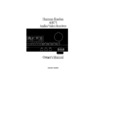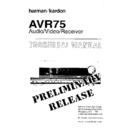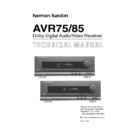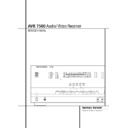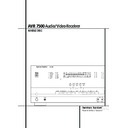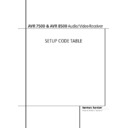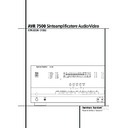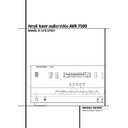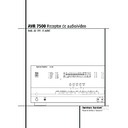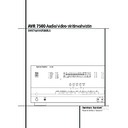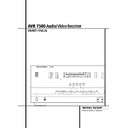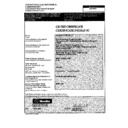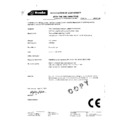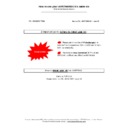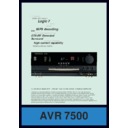Harman Kardon AVR 75 (serv.man3) User Manual / Operation Manual ▷ View online
Advanced Features
AVR75 120 rev (c) 8/27/97
31
The first time a PCM source is played the
AVR75 will automatically select the
Stereo mode, but you may then select
any surround mode desired.
AVR75 will automatically select the
Stereo mode, but you may then select
any surround mode desired.
Recording When Digital Sources
Are In Use
Since the record outputs of the AVR75
are traditional two-channel stereo, the
multichannel outputs of a Dolby Digital
signal may not be recorded. When any
Are In Use
Since the record outputs of the AVR75
are traditional two-channel stereo, the
multichannel outputs of a Dolby Digital
signal may not be recorded. When any
digital signal is being played, the accom-
panying analog audio signal is sent to
the
panying analog audio signal is sent to
the
Tape Out
and
VCR Out
jacks
£
∞ e h
. The video source being output
is the last selected video input shown in
the
the
Visual
indicator
P
.
MODE
DOLBY DIGITAL
DOLBY PRO LOGIC
DOLBY 3 STEREO
MOVIE SURROUND
HALL SURROUND
MATRIX SURROUND
STEREO
FEATURES
This mode is used only when the source material is encoded with Dolby Digital (AC-3)
data. It provides up to five separate main audio channels and a special dedicated Low-
Frequency Effects channel. Use this mode with DVD, LV or HDTV sources featuring
Dolby Digital playback.
data. It provides up to five separate main audio channels and a special dedicated Low-
Frequency Effects channel. Use this mode with DVD, LV or HDTV sources featuring
Dolby Digital playback.
Dolby Pro Logic is the standard mode for surround sound decoding. It uses
information encoded in a two-channel stereo recording to produce four distinct
channels: Left, Center, Right and Surround. Use this mode for accurate reproduction
of programs bearing the Dolby Surround, DTS Stereo, UltraStereo or other
“Surround” logos. Surround encoded programs include videocassette, DVD and LD
movies, TV and cable programs, radio programs and audio CDs. Dolby Pro Logic
processing may also be used to provide a pleasing surround effect with some
stereophonic source material that does not carry surround encoding.
information encoded in a two-channel stereo recording to produce four distinct
channels: Left, Center, Right and Surround. Use this mode for accurate reproduction
of programs bearing the Dolby Surround, DTS Stereo, UltraStereo or other
“Surround” logos. Surround encoded programs include videocassette, DVD and LD
movies, TV and cable programs, radio programs and audio CDs. Dolby Pro Logic
processing may also be used to provide a pleasing surround effect with some
stereophonic source material that does not carry surround encoding.
Dolby 3 Stereo uses the information contained in a surround encoded or two-channel
stereo program to create center channel information. In addition, the information
that is normally sent to the rear channel surround speakers is carefully mixed in with
the front left and right channels for increased realism. Use this mode when you have a
center channel speaker, but no surround speakers.
stereo program to create center channel information. In addition, the information
that is normally sent to the rear channel surround speakers is carefully mixed in with
the front left and right channels for increased realism. Use this mode when you have a
center channel speaker, but no surround speakers.
Movie Surround processing uses matrix surround decoding, with the option to extend
the delay time to 90 ms. Use this to experiment with surround times above 30 ms, or if
the delay time formula suggests a longer time delay for your room.
the delay time to 90 ms. Use this to experiment with surround times above 30 ms, or if
the delay time formula suggests a longer time delay for your room.
This mode is designed for use with stereo recordings. It provides a sound-field effect
that simulates the complex combination of direct and reflected sounds that create
the rich reverberant atmosphere of a medium-sized circular concert hall.
that simulates the complex combination of direct and reflected sounds that create
the rich reverberant atmosphere of a medium-sized circular concert hall.
This mode is designed for use with sports broadcasts, live concerts or other programs
where the feeling of a wide surround effect is desired.
where the feeling of a wide surround effect is desired.
This mode turns off all surround processing and presents the pure left and right
channel presentation of two channel stereo programs.
channel presentation of two channel stereo programs.
DELAY TIME RANGE
Center: 0 ms – 5 ms
Surround: 0 ms – 15 ms
Surround: 0 ms – 15 ms
15 ms – 30 ms
Initial Setting = 20 ms
Initial Setting = 20 ms
No Surround Channels
40 ms – 90 ms
Initial Setting = 40 ms
Initial Setting = 40 ms
40 ms – 90 ms
Initial Setting = 40 ms
Initial Setting = 40 ms
40 ms – 90 ms
Initial Setting = 40 ms
Initial Setting = 40 ms
No Surround Channels
Surround Mode Chart
AVR75 om (c) 9/16/98 11:33 AM Page 31
Troubleshooting
32
AVR75 120 rev (c) 8/27/97
SYMPTOM
No front panel lights when power
switch is pressed
Display lights, but no sound
or picture
or picture
No sound from any speaker.
Light around power switch is red
Light around power switch is red
No sound from surround or
center speakers
center speakers
No On-Screen Control Menus
Unit does not respond to
remote commands
remote commands
Intermittent buzzing in tuner
CAUSE
• No AC Power
• Intermittent input connections
•
Mute
is on
• Volume control is down
• Amplifier is in protection mode
due to possible short
• Amplifier is in protection mode
due to internal problems
• Incorrect surround mode
• Input is monaural
• Incorrect configuration
• Input is monaural
• Incorrect configuration
• TV input is S-Video
• Weak batteries in remote.
• Remote is in
• Remote is in
Learn
position
• Remote sensor is obscured
• Local interference
SOLUTION
• Make certain AC power cord is plugged into
a live outlet.
• Check to see if outlet is switch controlled.
• Make certain that all input and speaker connections
are secure.
• Press
Mute
button.
• Turn up volume control.
• Check speaker wire connections
at receiver and speaker ends for shorts.
• Contact your local Harman Kardon service depot.
• Select a mode other than Stereo or Monaural.
• There is no surround information from mono sources.
• Check configuration in
• There is no surround information from mono sources.
• Check configuration in
SET UP MENU 1
.
• Change TV connection and input to Composite Video.
The menus are available ONLY on Composite Video.
• Change remote batteries.
• Slide
• Slide
Use/Learn
switch to
Use
.
• Make certain front panel sensor is visible to remote.
• Move unit or antenna away from computers, fluorescent
lights, motors or other electrical appliances.
Troubleshooting Guide
Memory Backup
This product is equipped with a memory
backup system that preserves tuner pre-
sets and system configuration informa-
tion if the unit is accidentally unplugged
or subject to a power outage. This mem-
ory will last for approximately one week,
after which time all information must be
re-entered.
This product is equipped with a memory
backup system that preserves tuner pre-
sets and system configuration informa-
tion if the unit is accidentally unplugged
or subject to a power outage. This mem-
ory will last for approximately one week,
after which time all information must be
re-entered.
System Reset
In the rare case where the unit’s opera-
tion or the displays seem abnormal, the
cause may involve the erratic operation of
the system’s memory or microprocessor.
In the rare case where the unit’s opera-
tion or the displays seem abnormal, the
cause may involve the erratic operation of
the system’s memory or microprocessor.
To correct this problem, first unplug the
unit from the AC wall outlet and wait at
least three minutes. After the pause,
reconnect the AC power cord and check
the unit’s operation. If the system still
malfunctions, a system reset may clear
the problem.
unit from the AC wall outlet and wait at
least three minutes. After the pause,
reconnect the AC power cord and check
the unit’s operation. If the system still
malfunctions, a system reset may clear
the problem.
To clear the entire system memory of the
unit, press and hold the
unit, press and hold the
MEMO
%
and
CLEAR
^
buttons until
CLEAR MEMO
appears in the front panel display.
Release the buttons and note that the
unit will turn off and then on.
Release the buttons and note that the
unit will turn off and then on.
Remember that once you have cleared
the memory in this fashion it will be
necessary to re-establish all system
configuration information and tuner
presets.
the memory in this fashion it will be
necessary to re-establish all system
configuration information and tuner
presets.
If the system is still operating incorrectly,
there may have been an electrostatic
discharge or severe AC line interference
that has corrupted the memory or
microprocessor.
there may have been an electrostatic
discharge or severe AC line interference
that has corrupted the memory or
microprocessor.
If a reset does not solve the problem,
consult an authorized Harman Kardon
service depot.
consult an authorized Harman Kardon
service depot.
AVR75 om (c) 9/16/98 11:33 AM Page 32
Technical Specifications
33
AVR75 120 rev (c) 8/27/97
Audio Section
Stereo Mode
Continuous Average Power (FTC)
Continuous Average Power (FTC)
70 Watts per channel 20Hz–20kHz:
@ < 0.07% THD, both channels driven into 8 Ohms
@ < 0.07% THD, both channels driven into 8 Ohms
Five-Channel Surround Mode
Power Per Individual Channel
Power Per Individual Channel
Front L&R channels:
65 Watts per channel,
@ 0.07% THD, 20Hz–20kHz into 8 ohms
65 Watts per channel,
@ 0.07% THD, 20Hz–20kHz into 8 ohms
Center channel:
65 Watts, 20Hz–20kHz into 8 ohms
65 Watts, 20Hz–20kHz into 8 ohms
Surround channels:
65 Watts per channel, 40Hz–20kHz into 8 ohms
65 Watts per channel, 40Hz–20kHz into 8 ohms
Input Sensitivity/Impedance
Linear
220mV/50 Kohms
Signal-to-Noise Ratio (IHF-A)
Linear
95dB
Surround System Adjacent Channel Separation
Analog Decoding (Pro Logic, etc.) 40dB
Dolby Digital (AC-3)
Analog Decoding (Pro Logic, etc.) 40dB
Dolby Digital (AC-3)
55dB
Frequency Response
@ 1W (+0, –3dB)
7Hz–80kHz
High Instantaneous
Current Capability (HCC)
Current Capability (HCC)
±65 amps
Transient Intermodulation
Distortion (TIM)
Distortion (TIM)
Unmeasurable
Rise Time
16 µsec
Slew Rate
40 V/µsec
FM Tuner Section
Frequency Range
87.5–108.0 MHz
Usable Sensitivity
IHF 1.3 µV/13.5dBf
Signal-to-Noise Ratio
Mono/Stereo 76/68dB
Distortion
Mono/Stereo 0.2/0.5%
Stereo Separation
1kHz 40dB
Selectivity
±400kHz 65dB
Image Rejection
98MHz 50dB
Tuner Output Level
1kHz, ±75kHz Dev 800mV
AM Tuner Section
Frequency Range
520–1710kHz
Signal-to-Noise Ratio
50dB
Usable Sensitivity
Loop 500µV
Distortion
1kHz, 30% Mod 0.5%
Selectivity
±20kHz 70dB
Video Section
Television Format
NTSC
Input Level/Impedance
1Vp-p/75ohms
Output Level/Impedance
1Vp-p/75ohms
Video Frequency Response 10Hz to 8MHz (-3dB)
S/N
S/N
65dB
General
Power Requirement
AC 120V 60Hz
Power Consumption
80W idle, 325W maximum
(2 channels driven)
(2 channels driven)
Dimension (Max)
Width
17.4 inches (440 mm)
Height
6.3 inches (160 mm)
Depth
18.0 inches (459 mm)
Weight
32.6 lbs. (14.8 kg)
Depth measurement includes knobs, buttons and terminal connections.
All features and specifications are subject to change without notice.
*Trademarks of Dolby Laboratories.
†
DTS is a trademark of Digital Theater Systems.
††
UltraStereo is a trademark of UltraStereo Corp.
AVR75 om (c) 9/16/98 11:33 AM Page 36
AVR75 120 rev (c) 8/27/97
AM•FM
T•MON
CD
T•2
TV
DVD
V1
V2
V3
OSD
ATT
MEMO
Bass
Phones
Night
Power
Coax
OPT
RF
Digital Input
Treble
Balanc
P•SET
P•SCN
L
Max
Min
Max
Min
CLR
MODE
AVR 75
Mode
VISUAL
TV DVD V1 V2 V3
TEST
DIGITAL
STEREO
AC-3
PCM
PRO
•
LOGIC
3
•
STEREO
MOVIE
HALL
MATRIX
SLEEP
NIGHT
P-SCAN
LFE
ATT
DISP
MEMO AUTO TUNED
STEREO
dB
kHz
MHz
RF
OPT
COAX
Printed in Japan
Part #1111-AVR75
294J851250
AVR75 om (c) 9/16/98 11:33 AM Page 33

